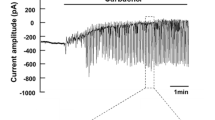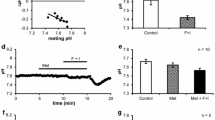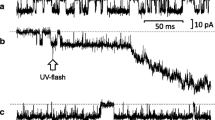Abstract
Transmembrane fluxes of36Cl were investigated in dispersed acini of the rat submandibular gland in Ca2+-containing and Ca2+-free media and also in the presence of the divalent cation ionophore A23187. In Ca2+-replete medium, a time-dependent uptake of tracer resulted in a steady state36Cl content of 8.5±0.3 nmol/mg protein in 3–5 min. This uptake was reduced 32% by 1 mM furosemide and 27% by 1 μM acetylcholine. In the presence of Ca2+, the ionophore (10−5 M) reduced tracer uptake 36% and prevented further effects of either acetylcholine or furosemide. Both acetylcholine and A23187 caused a rapid net efflux of36Cl from tracer-preloaded acini in Ca2+-containing medium (37% and 20%, respectively). When Ca2+ was omitted from the incubation medium, basal36Cl uptake in the absence of added test substance was the same as in Ca2+-containing medium but was not affected by acetylcholine, while it was still reduced 29% by furosemide. Addition of acetylcholine to preloaded acini in Ca2+-free medium caused only a transient and unsustained36Cl efflux but subsequent addition of Ca2+ produced a 36% reduction in tracer content. The ionophore caused a net36Cl efflux in Ca2+-containing medium (24% decrease in36Cl content) but had no effect in Ca2+-free medium. Subsequent addition of Ca2+ resulted in a 27% net efflux of tracer. The calmodulin inhibitor triflouperazine caused a 14% increase in36Cl uptake but did not cause36Cl efflux from preloaded cells or modify acetylcholine-induced efflux of tracer from these cells. These results suggest that intracellular Ca2+ regulates the efflux but not the uptake of Cl into salivary cells. Since this efflux is thought to occur by way of luminal membrane channels in salivary acini, the role of Ca2+ is likely to be to control the opening of these channels. Ca2+ does not seem to regulate Cl entry into salivary acini directly, but, after binding to calmodulin, may modulate some aspects of Cl entry into salivary cells.
Similar content being viewed by others
References
Blatz AL, Magleby KL (1983) Single voltage-dependent chloride-selective channels of large conductance in cultured rat muscle. Biophys J 43:237–241
Case RM, Hunter M, Novak I, Young JA (1984) The anionic basis of fluid secretion by the rabbit mandibular salivary gland. J Physiol (Lond) 349:619–630
Findlay I, Petersen OH (1985) Acetylcholine stimulates a Ca2+-dependent Cl− conductance in mouse lacrimal acinar cells. Pflügers Arch 403:328–330
Gallacher DV, Petersen OH (1983) Stimulus-secretion coupling in mammalian salivary glands. Int Rev Physiol 28:1–52
Greger R, Gogelein H (1985) Cl− channels in the apical cell membrane of the rectal gland “induced” by cAMP. Pflügers Arch 403:446–448
Hoffman EK, Lambert IH, Simonsen LO (1984) Separate K+ and Cl− transport pathways activated by Ca2+ in Ehrlich mouse ascites tumor cells. J Physiol (Lond) 357:62P
Hunter M, Smith PA, Case RM (1983) The dependence of fluid secretion by mandibular salivary gland and pancreas on extracellular calcium. Cell Calcium 4:307–317
Koelz HR, Kondo S, Blum AL, Schulz I (1977) Calcium ion uptake induced by cholinergic and α-adrenergic stimulation in isolated cells of rat salivary glands. Pflügers Arch 370:37–44
Lowry OH, Rosebrough NF, Farrar AL, Randall RJ (1951) Protein measurement with the Folin phenol reagent. J Biol Chem 193:265–268
Martinez JR, Petersen OH (1971) The importance of extracellular calcium for acetylcholine-evoked salivary secretion. Experientia 28:167–168
Martinez JR, Quissell DO (1976) Potassium release from the rat submaxillary gland in vitro. II. Induction by parasympathomimetric secretagogues. J Pharmacol Exp Ther 199:518–525
Martinez JR, Cassity N (1983a) Effect of transport inhibitors on secretion by perfused rat submandibular gland. Am J Physiol 245:G711-G716
Martinez JR, Cassity N (1983b) Salivary secretion induced from isolated, perfused rat submandibular glands by sympathomimetric agents. Arch Oral Biol 28:1101–1108
Martinez JR, Cassity N (1984) Effects of ouabain and furosemide on saliva secretion induced by sympathomimetic agents in isolated, perfused rat submandibular glands. Experientia 40:557–559
Martinez JR, Cassity N (1985a)36Cl fluxes in dispersed rat submandibular acini. Effects of acetylcholine and transport inhibitors. Pflügers Arch 403:50–54
Martinez JR, Cassity N (1985b) Cl− requirement for saliva secretion in the isolated, perfused rat submandibular gland. Am J Physiol 249:G464-G469
Marty A, Tan YP, Trautman A (1984) Three types of calcium-dependent channel in rat lacrimal glands. J Physiol (Lond) 357:293–325
McPherson MA, Dormer RL (1984) Mucin release and calcium fluxes in isolated rat submandibular acini. Biochem J 224:473–481
Nauntofte B, Poulsen JH (1984) Chloride transport in rat parotid acini: furosemide-sensitive uptake and calcium-dependent release. J Physiol (Lond) 357:61P
Petersen OH, Maruyama Y (1984) Calcium-activated potassium channels and their role in secretion. Nature 307:693–696
Poulsen JH, Laugesen LP, Nielsen JOD (1982) Evidence supporting that basolaterally located Na, K ATPase and a cotransport system for sodium and chloride are key elements in secretion of primary saliva. In: Case RM, Garner A, Turnberg LA, Young JA (eds) Electrolyte and water transport across gastrointestinal epithelia. Raven Press, New York, pp 157–160
Putney JW Jr (1976) Stimulation of45Ca influx in rat parotid gland by carbachol. J Pharmacol Exp Ther 199:526–537
Quissell DO (1980) Secretory response of dispersed rat submandibular cells. I. Potassium release. Am J Physiol 238:C90-C98
Saito Y, Ozawa T, Hayashi H, Nishiyama A (1985) Acetylcholine-induced change in intracellular Cl− activity of the mouse lacrimal acinar cells. Pflügers Arch 405:108–111
Weiss B, Prozialek W, Cimino M, Barnette MS, Wallace TL (1980) Pharmacological regulation of calmodulin. Ann NY Acad Sci 256:319–345
Welsh M (1983) Inhibition of chloride secretion by furosemide in canine tracheal epithelium. J Membr Biol 71:219–226
Author information
Authors and Affiliations
Rights and permissions
About this article
Cite this article
Ricardo Martinez, J., Cassity, N. 36Cl fluxes in dispersed rat submandibular acini: Effects of Ca2+ omission and of the ionophore A23187. Pflugers Arch. 407, 615–619 (1986). https://doi.org/10.1007/BF00582641
Received:
Accepted:
Issue Date:
DOI: https://doi.org/10.1007/BF00582641




